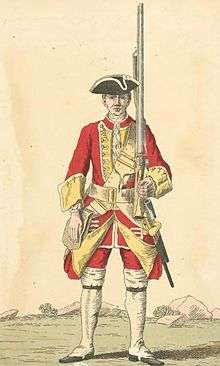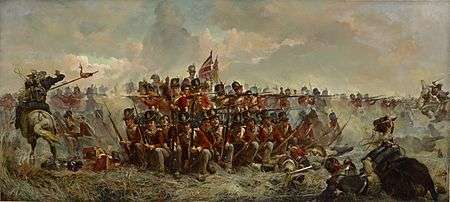28th (North Gloucestershire) Regiment of Foot
| 28th (North Gloucestershire) Regiment of Foot | |
|---|---|
| Active | 1694 – 1 July 1881 |
| Allegiance |
|
| Branch |
|
| Type | Line Infantry |
| Size | One battalion |
| Garrison/HQ | Horfield Barracks, Bristol |
| Nickname(s) | The Old Braggs, The Slashers |
The 28th (North Gloucestershire) Regiment of Foot was a line infantry regiment of the British Army. In 1881 they merged with the 61st (South Gloucestershire) Regiment of Foot to form the Gloucestershire Regiment.
History
Early years

The regiment was first raised by Colonel Sir John Gibson, who had served as the Lieutenant-Governor of Portsmouth, as Sir John Gibson's Regiment of Foot on 16 February 1694.[1] It was posted to Newfoundland to protect the colony there, losing many of its men to the extreme cold.[2] The regiment was disbanded in 1697,[1] but reformed under the same colonel in 1702.[1] Posted to the continent during the War of the Spanish Succession the regiment fought at the Battle of Elixheim in July 1705 and at Battle of Ramillies in May 1706.[2] It was then sent to the Spain, losing over half its men at the Battle of Almansa in April 1707, and then took part in the capture of Vigo in October 1719 during the War of the Quadruple Alliance.[2]
The regiment saw action in Flanders during the War of the Austrian Succession and, having been designated the 28th Regiment of Foot in 1751,[1] it took part in the Battle of Louisburg in June 1758 and the Battle of the Plains of Abraham at Quebec in September 1759 during the Seven Years' War.[2] The regiment was sent back in North America in May 1776 and took part in the Battle of White Plains in October 1776 during the American War of Independence.[2] It also fought in the West Indies and helped take Saint Lucia in 1778, but was captured by the French on Saint Kitts in 1782 and interned until the end of the war.[2] In 1782, renamed the 28th (North Gloucestershire) Regiment of Foot as part of the reforms to create a territorial association for each regiment,[1] it returned to Flanders following the outbreak of war with revolutionary France in 1793 and moved to the West Indies in 1795.[2] A detachment remained in Gibraltar before being moved to Minorca in 1798.[2]
Napoleonic Wars
In March 1801 the regiment formed part of the British expeditionary force that landed at Aboukir Bay in Egypt to oppose Napoleon's Army of the East. On 21 March, during the Battle of Alexandria, French cavalry broke through the British lines, formed up behind the regiment , and began to charge. Still heavily engaged to their front, the order was given "Rear Rank, 28th! Right About Face", and standing thus in two ranks, back to back, the regiment successfully defended itself. For this action the regiment was accorded the unique privilege of wearing the regimental number both on the front and the back of its head-dress.[3]
The regiment was dispatched to Denmark and took part in the Battle of Copenhagen in August 1807 during the Gunboat War.[4] The regiment next landed in Portugal in July 1808 for service in the Peninsular War.[5] It took part in the Battle of Corunna on 16 January 1809[6] before being evacuated from the Peninsular the following day.[7] A detachment remained behind and fought at the battle of Battle of Talavera in July 1809.[8] The remainder of the regiment went on to take part in the disastrous Walcheren Campaign in summer 1809.[9]
The regiment returned to the Peninsular in January 1810.[10] It saw action at the Battle of Barrosa in March 1811,[11] the Battle of Albuera in May 1811[12] and the Battle of Arroyo dos Molinos in October 1811,[13] as well as the Battle of Vitoria in June 1813[14] and the Battle of the Pyrenees in July 1813.[15] It then pursued the French Army into France and fought at the Battle of Nivelle in November 1813,[16] the Battle of the Nive in December 1813,[17] the Battle of Orthez in February 1814[18] and the Battle of Toulouse in April 1814.[19] It was one of the few Peninsula veteran regiments which was available for the Hundred Days campaign and fought at the Battle of Quatre Bras and at the Battle of Waterloo, as part of the 8th Brigade commanded by James Kempt, in June 1815.[20] Because of its actions in this campaign, the regiment earned distinguished mention in the dispatches of the Duke of Wellington.[2]
The Victorian era
After the war the regiment spent the next 20 years in the Mediterranean, Ireland and England, before being posted to Australia as garrison troops. It served in India from 1842 to 1848 and fought at the Battle of Alma in September 1854, the Battle of Inkerman in November 1854 and the Siege of Sevastopol in winter 1854 during the Crimean War.[2] It then served in India from 1858 to 1865, before spending further time in the Mediterranean.[2] As part of the Cardwell Reforms of the 1870s, where single-battalion regiments were linked together to share a single depot and recruiting district in the United Kingdom, the 28th was linked with the 61st (South Gloucestershire) Regiment of Foot, and assigned to district no. 37 at Horfield Barracks in Bristol.[21] The final postings were to Hong Kong, Singapore, Malacca and Penang,[2] before the regiment was merged with the 61st (South Gloucestershire) Regiment of Foot in 1881 to form the Gloucestershire Regiment.[1]

Archive material of the 28th Regiment of Foot is held by The Soldiers of Gloucestershire Museum in the Historic Docks Gloucester.[22]
Battle honours
The Battle Honours of the regiment were:[1]
- Egypt campaign: No individual battle honours were awarded immediately after the campaign, instead the Sphinx badge superscribed "Egypt" (8 March –26 August 1801) was awarded in 1802. Mandora, awarded 1813–1817. The battles of the campaign which the 28th were involved in were: Aboukir, Roman Camp, Alexandria (21 March), Cairo, Alexandria (17 August – 2 September 1801)
- Peninsula War: Corunna, Talavera, Barrosa, Albuhera, Vitoria, Pyrenees, Nivelle, Nive, Orthes, Toulouse, Peninsula
- Napoleonic Wars: Quatre Bras, Waterloo
- Crimean War: Alma, Inkerman, Sevastopol
- Ramillies, Louisburg, Quebec 1759 (all presented to successor regiment in 1882)
- Guadaloupe 1759, Martinique 1762, Havannah, St Lucia 1778 (all presented to successor regiment in 1909)
Regimental Colonels
Colonels of the Regiment were: [1]
- 1694–1697: Col. Sir John Gibson
- disbanded 1697
- reformed 1702
- 1702–1704: Col. Sir John Gibson
- 1704–1706: Maj-Gen. Sampson de Lalo
- 1706–1709: Brig-Gen. John Mordaunt, Viscount Mordaunt
- 1709–1715: Brig-Gen. Andrews Windsor
- 1715–1730: Lt-Gen. William Barrell
- 1730–1734: Maj-Gen. Nicholas Price
- 1734–1759: Lt-Gen. Philip Bragg
- 28th Regiment of Foot - (1751)
- 1759–1773: F.M. George Townshend, 1st Marquess Townshend
- 1773–1777: Maj-Gen. Thomas Erle
- 1777–1787: Gen. Sir Charles Grey, 1st Earl Grey, KB
- 28th (the North Gloucestershire) Regiment of Foot - (1782)
- 1787–1789: Maj-Gen. James Paterson
- 1789–1815: Gen. Robert Prescott
- 1815–1849: Gen. Hon. Sir Edward Paget, GCB
- 1849–1854: Lt-Gen. John Duffy, CB, KC
- 1854–1878: Gen. Sir Henry John William Bentinck, KCB [23]
- 1878–1880: Gen. Thomas Brooke
- 1880–1881: Gen. Julius Edmund Goodwyn, CB
References
- 1 2 3 4 5 6 7 8 "28th (North Gloucestershire) Regiment of Foot". regiments.org. Archived from the original on 13 January 2008.
- 1 2 3 4 5 6 7 8 9 10 11 12 "28th (North Gloucestershire) Regiment of Foot". National Army Museum. Retrieved 12 September 2016.
- ↑ Daniell pp.69-75
- ↑ Cadell, p. 8
- ↑ Cadell, p. 29
- ↑ Cadell, p. 69
- ↑ Cadell, p. 72
- ↑ Cadell, p. 74
- ↑ Cadell, p. 76
- ↑ Cadell, p. 85
- ↑ Cadell, p. 94
- ↑ Cadell, p. 110
- ↑ "Battle of Arroyo dos Molinos". Napoleon Series. Retrieved 23 October 2016.
- ↑ Cadell, p. 155
- ↑ Cadell, p. 172
- ↑ Cadell, p. 187
- ↑ Cadell, p. 192
- ↑ Cadell, p. 212
- ↑ Cadell, p. 219
- ↑ Cadell, p. 232
- ↑ "Training Depots". Regiments.org. Retrieved 16 October 2016.
- ↑ "Welcome". The Soldiers of Gloucestershire Museum. Retrieved 3 October 2016.
- ↑ The London Gazette: no. 21640. p. 4051. 12 December 1854. Retrieved 7 November 2009.
Sources
- Cadell, Charles, Lieutenant Colonel (1835). Narrative of the campaigns of the Twenty-Eighth Regiment since their return from Egypt in 1802. Whittaker & Co.
- Daniell, David Scott (1951). Cap of Honour: The story of the Gloucestershire Regiment (the 28th/61st Foot) 1694-1950. London, George G. Harrap and Co.
Further reading
- Brodigan, F., Lieutenant Colonel (1884). Historical Records of the Twenty-Eighth North Gloucestershire Regiment from 1692 to 1882. Blackfriars Publishing.